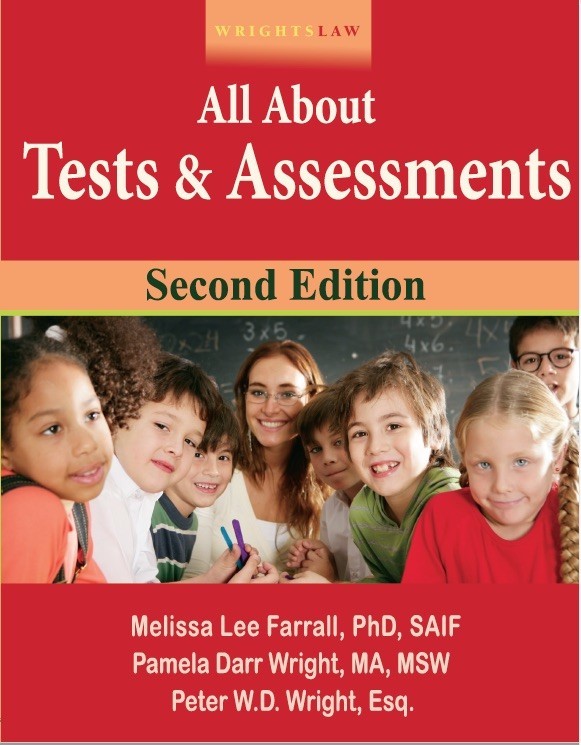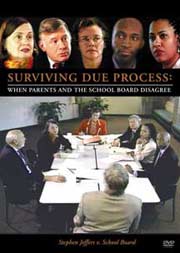|
Home
|
The Special Ed Advocate is a free online newsletter about special education legal issues, cases, tactics and strategy, effective educational methods, and Internet links.
Invite your friends and colleagues to subscribe to The Special Ed Advocate. Our subscription form makes it easy to subscribe (instructions at end of this newsletter).
Read and search back issues of The Special Ed Advocate at
https://www.wrightslaw.com/archives.htm
The Special Ed Advocate newsletter is sent by permission only. If you wish to unsubscribe at any time, you will find directions about how to unsubscribe are at the end of this newsletter. Thanks!
1. Update: IDEA Compliance Report
On February 2, we sent out a newsletter about the new IDEA Compliance Report. We suggested that you BOOKMARK the TOC page.
We explained that when you returned to the TOC page, you’d see the "links" on this page fill in as we added new files.
If you returned to the TOC page during the past two days, you know that we’ve been uploading new files that contain the "meat" of this report.
HOW DOES YOUR STATE COMPARE?
How did your state compare? What are your state’s strengths? Weaknesses?
You’ll find answers to these questions in Part III of the IDEA Compliance Report (officially entitled "Grant Administration, Compliance Monitoring, Complaint Handling, and Enforcement Functions").
We divided Part III into two files (3A and 3B) to reduce download time.
SEARCH TIPS
Here are tips about how to find information about your state in this report:
Download the files into your hard drive. To find information about your state, open one of the files. Click "Edit" (on your toolbar), then click "Find in Page." Type the name of your state. Click "Find Next"
Here’s how this works in practice. I opened the first file, clicked "Edit," then clicked "Find in Page." I typed in "California" and clicked "Find in Page."
The first "find" is Table 2: Status of Approval of IDEA Part B State Plans/State Plan Reviews for 1995-96, 1994-95, and 1993-94.
I see that California got a "C" in each of these three years. When I scroll down, I see that "C" doesn’t mean "average" -- it means "conditional." California’s state plan got "conditional approval" for each of these three years.
I click "Find Next" for another "hit" on California and stop at "related services."
"OSEP found that 34 states (68%) had failed to ensure compliance with the related services requirements, as shown in the following examples:"
"In one district in California, an administrator told OSEP that there were 42 students whose IEPs called for speech services, but who were not receiving the services; in another district, an administrator reported that students whose IEP teams believed they needed mental health services to benefit from special education were referred to outside agencies for the services, rather than receiving the services free of charge through their IEPs.[129]"
When I click "Find Next" again, I skip to the LRE section of the report and read:
"Students with disabilities must participate with nondisabled peers in nonacademic and extracurricular activities and services to the maximum extent appropriate to their needs."
"OSEP found that 29 states (58%) had not ensured compliance with these requirements, as shown in the following examples:"
"In California, three administrators reported that "students identified as seriously emotionally disturbed who are served in a separate school program in the district, and students with disabilities who are served in the agency's preschool program (separate school), are not provided adequate opportunities for integration with age appropriate peers, regardless of individual need. [These administrators] reported to OSEP that as a general practice there was no individualized determination of the maximum extent to which each student with a disability placed in the separate school programs could participate with nondisabled children in nonacademic and extracurricular services and activities."[145]
When I click "Find Next" again, I skip to "Incarcerated Students." I read that:
"California Department of Corrections administrators responsible for educational programs in correctional facilities cited a recent study by that Department estimating that there are 6500-8500 youth with disabilities between the ages of 16 and 22 in the Department's facilities who would be eligible for special education and related services under current California law. They stated that the Department of Corrections currently offers adult basic education and literacy programs to assist inmates in attaining a high school diploma or high school graduation equivalency diploma, and provides adult literacy offerings, but that special education services are not currently available in any of the 29 facilities that house youth between 16 and 22."[163]"
I click "Find Next" again, and skip to "Correction of Deficiencies."
"States must adopt and use proper methods for the correction of deficiencies in program operations that are identified through monitoring."
"OSEP found that 28 states (56%) had failed to ensure the correction of deficiencies identified through their monitoring processes."
"In California, OSEP noted that ". . . many deficiencies identified in agency F in CDE's [California Department of Education's] 1993 review and OSEP's 1991 review were uncorrected."
"CDE's follow-up review, however, only confirmed that public agencies had established policies and procedures that were consistent with the requirements . . .; CDE did not investigate whether public agencies implemented these requirements, and OSEP found as part of its 1995 review that agency [F] continued to implement practices that were not consistent with these requirements."[175]
I open the second file of Part III, click "Edit," click "Find," type in "California," then click "Find Next." This took me to "Analysis of Six States" which is a comprehensive analysis of six states, including California.
"(a) California
Three monitoring reports from California were analyzed: 1988, 1992, and 1996. As displayed in the following table . . . California came into compliance with only one of 10 requirements (10%) over time -- the requirement under general supervision, the review and approval of LEA applications. Of the nine that remained non-compliant, seven remained non-compliant for almost eight years, and two for four years."
The Analysis of California’s noncompliance continues for several paragraphs.
2. Analysis of Six States: California, Illinois, New York, Oregon, Texas, Vermont (Part III)
If you live in one of these six states:
* CALIFORNIA ** ILLINOIS *
* NEW YORK *
* OREGON *
* TEXAS *
* VERMONT *
you’ll want to read "Analysis of Six States Over Time."
There’s an old saying, "A picture is worth a thousand words." "Analysis of Six States" includes charts of "noncompliance over time" that are pretty valuable too!
Analysis of Six States is in Part III of the Report
3. What Other Parents Are Saying (Part II)
Have you felt isolated? Powerless? Would you like to learn about the experiences of other parents of children with disabilities? Then you should read "Grassroots Perspectives on Noncompliance." (Part II of the Report)
Here are a few quotes from "Grassroots Perspectives":
"Every Parent Training and Information (PTI) center in the country hears daily about the toll taken on students whose educational needs are not being met and on parents who expend incredible amounts of energy advocating for basic access to educational programs for their children."
"The stress of working with a recalcitrant school system that does not want to work with a parent to educate a disabled child can be tremendous."
"Parents have a reasonable expectation that the federal and state agencies charged with monitoring and enforcement will do their jobs."
THE NEED TO CREATE CONSEQUENCES
Most parents were "extremely frustrated by the lack of enforcement and skeptical" about when the law would be implemented and enforced.
One parent said, "There is no enforcement, no teeth. It’s like making the speed limit on the highway 55 mph but taking away all of the police. Why do we have laws if no one is going to follow them?"
A parent advocate reported that at least 3 counties in GEORGIA "outright refuse to service students with disabilities under IDEA." Despite "repeated complaints, school districts take the attitude of ‘go ahead and try to make me.’"
"Although OSEP cited GEORGIA for this, it took the state TWO YEARS to respond to the report. As a result of this practice in GEORGIA, "students with learning disabilities are not learning to read, are becoming frustrated, and are dropping out of school."
Download "Grassroots Perspectives"
4. Links: IDEA Compliance Report
Bookmark the Table of Contents or Index page at:
Part II is where you’ll find out what other parents are saying about IDEA Compliance -- or lack of compliance!
Part III is where you will find most of the information about individual states. Part III is divided into two files: Part 111 A, Part 111 B
“Endnotes” contains the references used in this report:
5. Your Child's IEP: #1 Upload Again!
"Your Child's IEP: Legal and Practical Guidance" was the #1 download at Wrightslaw in January. The article was downloaded 8,737 times! If you don't have "Your Child's IEP,"
6. News Break! Court of Appeals Rules That Colorado Children Are not Entitled To "Quality Education" (February 4, 2000)
"Feb. 4 - In a landmark ruling, the Colorado Court of Appeals said Thursday that parents cannot sue public school districts if they believe their children have been denied a quality education."
"The decision came out of a case involving more than 3,400 parents who sued Denver Public Schools, claiming the district shortchanged students by not providing a quality education, especially for minorities."
"The lawsuit claimed that school districts had a "contractual duty" to provide a good education. But the court saw otherwise, saying if parents want change, they should force it at the ballot box and not in the courtroom."
To read "Court flunks suit over school quality" by Howard Pankratz of the Denver Post, go to
http://www.denverpost.com/news/news0204f.htm
| |||||
|
|
|||||
|
Copyright © 1998-2025, Peter W. D. Wright and Pamela Darr Wright. All rights reserved. Contact Us | Press l Mission l Our Awards l Privacy Policy l Disclaimer l Site Map |
|||||




